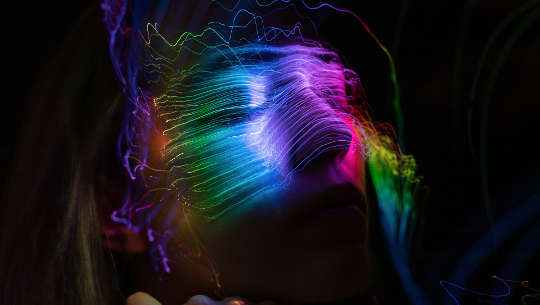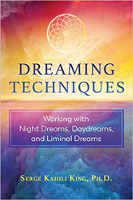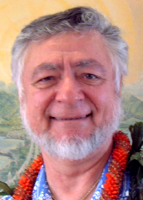
Image by Meryl Katys
Narrated by Marie T. Russell
It’s easy to oversimplify daydreaming by saying that all you have to do is imagine something, but for the budding Dream Technician I’m going to give some very useful exercises and practices.
For practical purposes I divide daydreams into two types, using the Hawaiian words hua and nalu.
Hua: Active Daydreaming
The word hua comes from the root hu, meaning “all kinds of movement, especially upward and outward.” Hua means “the seed or egg of something,” as well as “the fruit or result,” and so can be used to mean “producing” or “yielding.” In short, and for my purposes, it refers to the type of daydream in which you actively cause things to happen, note the results, and initiate more activity.
Another common word for this is to fantasize. In a hua daydream, you are the director, so the first exercise is simply to make up some daydreams. An easy way to do this is to take stories you know from books, movies, or television, and make up your own variations of them. You can include yourself in these hua daydreams, or not. For some people it may sound silly, but this will actually increase your mental flexibility and awareness.
Nalu: Passive Daydreaming
The word nalu means “waves,” and also “to ponder or reflect.” It is not the same as what is currently called mindfulness, which, while beneficial in many ways, is the opposite of daydreaming.
You practice nalu by picking a topic about which you would like to have more information or insights. It could be anything at all, but doing nalu with broad topics such as love, life, power, confidence, peace, and the like can be very interesting. Specific topics like a relationship, a computer problem, a job, and so on can also provide insights.
The actual exercise involves keeping your attention on the topic very gently and just letting ideas, memories, expectations, and anything else related to the topic come and go. The more relaxed you are while you do it, the more likely it is that insights will appear, but for some people it will take practice to get useful results.
Finding the Blank Spots
This exercise is designed to help show you where you may need to make changes in your thinking or in your life. You start by thinking of something you want to do, be, or have, and then you imagine doing, being, or having it in as much detail as possible. What you are looking for are blank spots, or areas where you find it difficult or impossible to imagine something.
As an example, when I was guiding a woman who had prosperity problems, she would imagine swimming in pools of money and having money rain down on her in great amounts, but she could not imagine receiving a raise of five more dollars.
If you find a similar blank spot during this exercise, intensify your focus so you can imagine it. Write down that part of your imagining to make it easier, or use some other technique to increase your self-esteem or self-confidence to the point where you can accept it and imagine it easily.
Stretching the Possibilities
Imagine something you want to do, be, or have, and take it to extremes. If you can imagine receiving a five-dollar raise with no problem, try swimming in unlimited amounts of money. If you want more social acceptance, imagine lots of people applauding you and calling out your name wherever you go. If you want to improve your health and strength, imagine in detail that you have the health and strength of Wonder Woman or Superman.
While you may not actually reach the point you imagine, both your mind and your body will strive to improve beyond your current expectations.
Self-Development Techniques
Purposeful Planning
Practice planning something you want to do in detail, including how you want it to come out. You may be surprised at how often it works out just like you want, but don’t be surprised either if it doesn’t, because the future is not fixed. Nevertheless, this exercise will help you to increase your awareness and flexibility, and make changes in the moment to stay on track, or as close as is feasible to do so.
Skill Training
You can use daydreaming to learn or improve any skill, especially if you add all the senses to the daydream. In my forties, I learned how to ski up to an intermediate level in one afternoon by watching skiers. I then imagined that I was doing what they were doing not only as a visual, but by feeling the movements they made as well. In college, I learned how to sail a boat in one hour by imagining myself as a Viking sailor beforehand.
Rehearsal
Just as actors rehearse in order to do well in a play, so you too can rehearse for social, business, or other situations that you feel uneasy about. Rehearsing what you intend to do generates memories that you and your body can call upon in the actual event.
It’s well known that people planning to give a speech do better when they practice by imagining that they are giving the speech in front of an imaginary audience. Sometimes they do this in front of a mirror, but that isn’t necessary. It’s very useful to imagine the applause of the audience as well.
If you are uncomfortable about meeting and mingling with people at social gatherings, imagine yourself being there, drink in hand or not, and shaking hands, speaking with people, and even introducing yourself to strangers who respond in a friendly way. People can be sensitive to your fears and insecurities, and rehearsal will reduce those feelings in yourself.
It’s important to do your imaginary rehearsal often enough and clearly enough that you will be able to go ahead and involve yourself in the actual situation you are rehearsing for.
Memory Training
One of the very best memorization techniques, used by top memory experts, is image association. This means to create a daydream that associates something you want to remember with an image of some kind.
Thoughtforming
There are innumerable possibilities for using thoughtforms. Here are a few to stimulate your own imagination.
Healing Thoughtforms
One thing you can do is to imagine your body, or a part of your body, as being different than it is, in size, shape, height, strength, or whatever. This may sound hard to believe, but if you intensively thoughtform your body in a particular way, other people will tend to perceive you that way.
In Africa, under the guidance of a shaman, I thoughtformed myself as a black panther quite often, and when I returned to the States quite a few people would say that I reminded them of a panther. One distant friend, who didn’t know anything about my experience, even sent me a birthday card with a black panther.
If one part of your body is healthy and another similar part is not, daydreaming that the parts have exchanged places can aid in the healing of the part that needs it. More importantly, though, if you practice a lot, your body will move toward duplicating your thoughtform to some degree.
You can also use thoughtforms of light or energy to infuse water with healing qualities. Maybe it’s a placebo effect, but it works very well. In a workshop of about a hundred people, I gave everyone a cup of water and had them imagine intensely that it was turning into wine. At least half of the group claimed they could definitely taste the difference.
Practical Thoughtforms
When I was young I had a tendency to get seasick, so I generated a thoughtform of being attached to bedrock by cables that moved with me as I went from place to place. This served me so well that I have taught others to use it to combat vertigo, dizziness, and balance problems.
Somewhat related is a technique designed to prevent problems like scrapes, cuts, bruises, broken bones, and even death, depending on the terrain. It sounds absurdly simple, but it can save your life, or at least keep you from getting hurt. When you are walking on slippery ground or climbing mountainous terrain, whether or not you are on a trail, imagine that there are steel spikes growing out of your feet or attached to the soles of your shoes. These spikes slide into the ground to give you a firm grip with each and every step. That’s it. That’s all. But boy, does it ever give you more secure footing.
The last one I’ll include here is what I like to call Assisted Climbing. Whether it’s while hiking uphill or climbing a flight of stairs, imagine something helping you up. I have used hot air balloons, imaginary donkeys, and, on one occasion, a thoughtform ATV.
Esoteric Techniques
For those who are interested, here are a couple of esoteric techniques that you can practice using daydreams.
Remote Viewing
This refers to an ability to see things in the present that are related to things at a distance, in the past, or in the future. One of the most ancient and widespread ways of doing this is called scrying. The most well-known method uses a crystal ball. However, in ancient Egypt they gazed into a pool of water, in ancient China they used a mirror, and in ancient Hawaii they used a piece of polished stone.
Conventional thinking says that, by some magical means, an image of what you are looking for appears inside the crystal ball or other object. After doing considerable research on this I can say without a doubt that the image appears on the surface of the object.
Unless you do some creative interpretation, it may or may not have anything to do with what you are looking for. In short, what you see when you do it is a daydream. In almost all cases, the scrying instrument has a reflective surface, well suited to produce a daydream image when gazed upon for some time in the right type of lighting.
I say almost, because I have experimented with a simple black circle on white paper and have obtained virtually the same results as with a crystal ball. Still, if you are relaxed enough, focused enough, and your intention is clear enough, you may actually see things related to the past, future, and distant present.
Remote Sensing
No tool or device is needed for this. Although it may involve visual and auditory aspects, the sense of touch is prominent in this technique. First, you create the daydream of having an invisible and somewhat tangible aura—a kind of energy field—that radiates from you and surrounds your body. Daydream as well that you have the ability to extend this aura outward in any direction as far as you want.
The practice of remote sensing consists of attempting to feel and see what is on the other side of what you can physically feel and see from where you are.
I like to do this in my forest to check the condition of plants that are out of my sight, and to look for wild pig tracks to see and feel if a sounder of swine (that’s the actual term for a group of adult pigs) has invaded overnight. I will often practice this in places where I’ve never been to and then check for any degree of accuracy.
Once, on a friend’s farm, I extended my aura from where I was on his lanai to an area farther into his forest, and was surprised to sense a large field of wild orchids. Sure enough, when I walked out into the forest, there were the orchids waiting for me.
©2017, 2020 by Serge King. All Rights Reserved.
Reprinted with permission of the publisher
Bear & Co, an imprint of Inner Traditions Intl.
www.innertraditions.com
Article Source
Dreaming Techniques: Working with Night Dreams, Daydreams, and Liminal Dreams
by Serge Kahili King
 Dreams can change our lives in profound and tangible ways. In this guide to mastering the art of dreaming, Serge Kahili King, Ph.D., explores techniques to harness the power of dreams for healing, transformation, and changing your experience of reality. Drawing on his analysis of more than 5,000 of his own dreams as well as those of students and clients from his almost 50 years of clinical work, he examines the types of night dreams we have, how to remember them better, how to make use of them to improve our health and well-being, and how to interpret them. The book also explores daydreams in depth, including fantasy, guided imagery, meditation, visions, and remote viewing and provides techniques for using daydreams for healing, insight, and creativity.
Dreams can change our lives in profound and tangible ways. In this guide to mastering the art of dreaming, Serge Kahili King, Ph.D., explores techniques to harness the power of dreams for healing, transformation, and changing your experience of reality. Drawing on his analysis of more than 5,000 of his own dreams as well as those of students and clients from his almost 50 years of clinical work, he examines the types of night dreams we have, how to remember them better, how to make use of them to improve our health and well-being, and how to interpret them. The book also explores daydreams in depth, including fantasy, guided imagery, meditation, visions, and remote viewing and provides techniques for using daydreams for healing, insight, and creativity.
For more info and/or to order this book, click here. Also available as a Kindle edition.
About the Author
 Serge Kahili King, Ph.D., is the author of many works on Huna and Hawaiian shamanism, including Urban Shaman and Instant Healing. He has a doctorate in psychology and was trained in shamanism by the Kahili family of Kauai as well as by African and Mongolian shamans. He is the executive director of Huna International, a non-profit worldwide network of individuals who have dedicated themselves to making the world a better place. He lives on the Big Island of Hawaii. Visit his website at http://www.huna.net/
Serge Kahili King, Ph.D., is the author of many works on Huna and Hawaiian shamanism, including Urban Shaman and Instant Healing. He has a doctorate in psychology and was trained in shamanism by the Kahili family of Kauai as well as by African and Mongolian shamans. He is the executive director of Huna International, a non-profit worldwide network of individuals who have dedicated themselves to making the world a better place. He lives on the Big Island of Hawaii. Visit his website at http://www.huna.net/




























